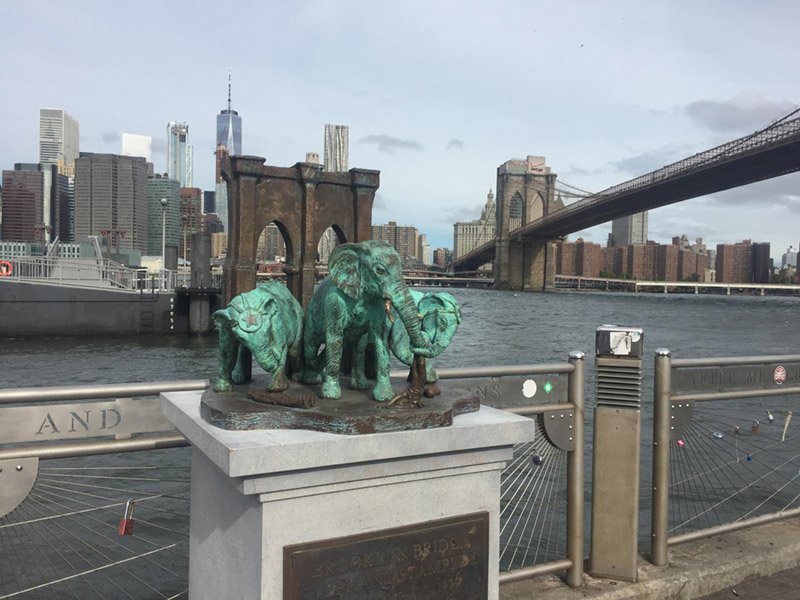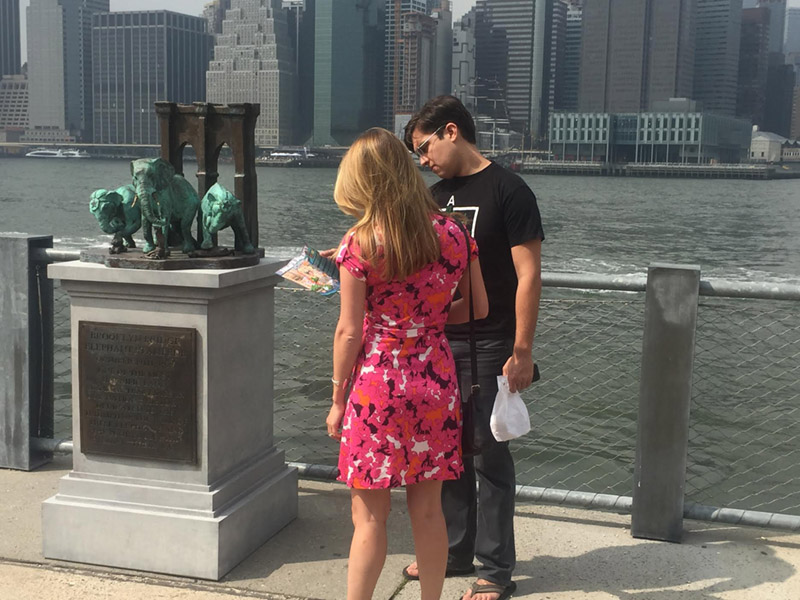 Image courtesy Joe Reginella
Image courtesy Joe Reginella
New York City is the perfect place for urban fabulists like sculptor Joe Reginella, the creator of the new Brooklyn Bridge Elephant Stampede monument. Now on view in Brooklyn Bridge Park, the intricate bronze sculpture stands as an homage to the elephants killed in an imaginary stampede that crossed the Brooklyn Bridge, wound its way downtown and passed through the Holland Tunnel. A little under six feet tall, it shows three elephants running amok, trampling people underfoot.
 Image courtesy Joe Reginella
Image courtesy Joe Reginella
Like all great stories, the story of this stampede is rooted in actual and interesting history; P. T. Barnum of Barnum and Bailey’s Circus was an enthusiast of the Brooklyn Bridge, considering it an architectural marvel as well as a great PR opportunity. As such, he offered to walk his elephants across it to prove its stability and to give his show a grand entrance when it came to town. Jumbo, his famous thirteen-foot and seven-ton African elephant, did indeed cross the bridge in 1884, along with twenty other elephants, seven camels and ten dromedaries in what was known as Barnum’s legendary “elephant walk.”
In Reginella’s lively and comic rendering of this story, Jumbo the elephant was coming to town with the circus on the evening of October 24, 1929, the day of the stock market crash. While crossing the bridge, an unfortunate panic attack among the elephants caused a stampede, and they trampled over each other and over the many onlookers in their frantic rush into an already chaotic downtown. Two of them died, and apparently Jumbo was last seen escaping through the Holland Tunnel—the monument, the pranksters declare, is dedicated to these beasts’ spirit for freedom.
 Image courtesy Joe Reginella
Image courtesy Joe Reginella
The multimedia project team has put in a lot of effort into bolstering this narrative and creating an exhaustive list of evidence—the Brooklyn Bridge Elephant Stampede has a website detailing this vivid “history”, where Jumbo’s stampede route downtown is fully mapped out. There’s an audio guide that has been read by New York Dolls’ David Johansen (a fellow Staten Island native along with Reginella), as well as a documentary, complete with interviews in old Disney or MGM-style voices.
The point of all this “evidence” is to create a strong and detailed story; the story doesn’t strike you as trying in full earnest to sell itself as history. There is a sense of parody and pure fun throughout the project.
“It’s cool if they believe it, but even if they don’t, it’s a fun story to look into,” Reginella told Untapped Cities. A few years ago, Joe Reginella also created a monument memorializing an octopus attack on a ferry in a Staten Island harbor, which was a similar multimedia project that involved brochures, a fake museum, and a documentary. “Even after the news broke that that story was fake, I brought the octopus statue to the park and people loved it. So I thought, why not do a project — sort of a forgotten New York story — every year?”
As Reginella was setting up the statue in the park, a woman who recognized him from his previous project approached and said, “Thank you for making things interesting.” Storytelling is its own way of paying homage to the city, and Reginella’s stories do just that. This “forgotten New York story” now sits quietly at the foot of the Brooklyn Bridge, adding more color to the endless other stories, both fact and myth, that surround this iconic New York structure.
To learn about more about the history and little known facts about the Brooklyn Bridge, join us for a Secrets of the Brooklyn Bridge Walking Tour!
The Secrets of Brooklyn Bridge Walking Tour
Next, read about the Monument to a Staten Island Ferry Attack by Giant Octopus in NYC.





